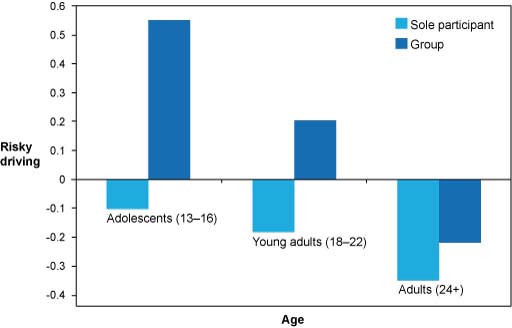2.1 Peer pressure and risk taking
You have already learned about an experiment, in which two different ‘conditions’ (the ‘director’ and ‘rules only’) were tested with different age groups.
Psychologists Gardner and Steinberg (2005) conducted an experiment to explore age differences in risk taking. They asked their participants to play a computerised driving game in which they were able to take risks (e.g. driving through an amber or red light) in the pursuit of accruing points, with the aim of getting as many points as possible. They split participants into three age groups (13-16, 18-22, 24+) and assigned them randomly to one of two conditions – playing alone or in the company of two age-matched peers.
Their findings (see figure below) demonstrated that risk taking was greatest in adolescents in the company of their peers, followed by adolescents who were alone. Young adults took greater risks when with their peers, although this was of a lower magnitude, and adults took fewest risks both when alone and with peers.

This study appears to demonstrate that peers have an important role in adolescent risk-taking, and supports the assertion that peers become of greater significance during adolescence. This is, of course, a laboratory-based study and how this relates to actual real-world processes is unclear.
It is still not well understood how an individual’s experiences and behaviours may influence their brain development, or what the implications of certain experiences or learning opportunities in the adolescent period are for the subsequent adult brain. This area of brain development is known as ‘experience-dependent plasticity’ (Dow-Edwards et al., 2019, p. 2). ‘Plasticity’ refers to the ability of the brain to adapt its structure and function in response to accumulated experience and behaviours. A classic example of plasticity is learning to play a musical instrument, in which the nerve pathways involved in controlling movements, reading music and listening to the sounds produced, are reinforced with practice (Herholz, 2012).
Research focusing on the effect of alcohol or drugs on the developing adolescent brain has revealed that these substances can interfere with normal brain development (Dow-Edwards et al., 2019; Spear, 2018). It may be encouraging to know that there are signs that young people are beginning to reject social pressures to drink alcohol (Larm et al., 2018; Vieno et al., 2018). In the next section, you’ll consider some of the other challenges of social pressures.

